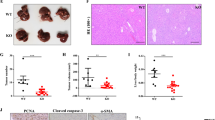Abstract
O-linked-ß-N-acetylglucosamine (O-GlcNAc) modification is a crucial post-translational modification. The enzymes responsible for the addition and removal of O-GlcNAc have been identified as O-GlcNAc transferase (OGT) and O-GlcNAcase (OGA). In this study, O-GlcNAcylation level was examined in forty hepatocellular carcinoma (HCC) tissues of patients who underwent liver transplantation (LT) and ten healthy liver tissues by immunohistochemistry analysis. We also examined the expression of OGT and OGA in sixty HCC samples using real-time reverse-transcription polymerase chain reaction and analyzed their correlations with clinical parameters and prognosis in sixty HCC patients treated with LT. Additionally, the global O-GlcNAcylation level was altered through OGT and OGA silencing in the HCC cell line, and the effects of O-GlcNAcylation on cancer malignancy were investigated. We found that the global O-GlcNAcylation levels were significantly elevated in HCC tissues than that in healthy liver tissues (P = 0.031); moreover, O-GlcNAcylation was significantly enhanced in the tumor tissues of patients who had suffered from HCC recurrence after LT compared with those who had not (P = 0.046). Importantly, low expression of OGA was an independent prognostic factor for predicting tumor recurrence of HCC following LT (P = 0.041, hazard ratio, 0.438), especially in AFP low patients. In vitro assays demonstrated that O-GlcNAcylation play important roles in migration, invasion, and viability of HCC cells, partly through regulating E-cadherin, MMP1, MMP2, and MMP3 expression. Altogether, these results suggest that O-GlcNAcylation might play important roles in HCC formation and progression and may be a potential marker to predict patient risk of recurrence after LT and a valuable target for therapy.






Similar content being viewed by others
References
El-Serag HB, Rudolph KL. Hepatocellular carcinoma: epidemiology and molecular carcinogenesis. Gastroenterology. 2007;132:2557–76.
Torres CR, Hart GW. Topography and polypeptide distribution of terminal N-acetylglucosamine residues on the surfaces of intact lymphocytes. Evidence O-linked GlcNAc J Biol Chem. 1984;259:3308–17.
Ozcan S, Andrali SS, Cantrell JE. Modulation of transcription factor function by O-GlcNAc modification. Biochim Biophys Acta. 2010;1799:353–64.
Zachara NE, Hart GW. The emerging significance of O-GlcNAc in cellular regulation. Chem Rev. 2002;102:431–8.
Liu F, Iqbal K, Grundke-Iqbal I, Hart GW, Gong CX. O-GlcNAcylation regulates phosphorylation of tau: a mechanism involved in Alzheimer’s disease. Proc Natl Acad Sci USA. 2004;101:10804–9.
Yang X, et al. Phosphoinositide signalling links O-GlcNAc transferase to insulin resistance. Nature. 2008;451:964–9.
Caldwell SA, et al. Nutrient sensor O-GlcNAc transferase regulates breast cancer tumorigenesis through targeting of the oncogenic transcription factor FoxM1. Oncogene. 2010;29:2831–42.
Gu Y, et al. GlcNAcylation plays an essential role in breast cancer metastasis. Cancer Res. 2010;70:6344–51.
Mi W, et al. O-GlcNAcylation is a novel regulator of lung and colon cancer malignancy. Biochim Biophys Acta. 2011;1812(4):514–9.
Wu LM, et al. MMP2 promoter polymorphism (C-1306T) and risk of recurrence in patients with hepatocellular carcinoma after transplantation. Clin Genet. 2008;73:273–8.
Zhang F, et al. Predictive value of expression and promoter hypermethylation of XAF1 in hepatitis B virus-associated hepatocellular carcinoma treated with transplantation. Ann Surg Oncol. 2008;15:3494–502.
Fromowitz FB, et al. Ras p21 expression in the progression of breast cancer. Hum Pathol. 1987;18:1268–75.
Yang Z, et al. Overexpression of long non-coding RNA HOTAIR predicts tumor recurrence in hepatocellular carcinoma patients following liver transplantation. Ann Surg Oncol. 2011 [Epub ahead of print].
Zheng SS, et al. Liver transplantation for hepatocellular carcinoma: Hangzhou experiences. Transplantation. 2008;85:1726–32.
Endo K, Ueda T, Ueyama J, Ohta T, Terada T. Immunoreactive E-cadherin, alpha-catenin, beta-catenin, and gamma-catenin proteins in hepatocellular carcinoma: relationships with tumor grade, clinicopathologic parameters, and patients’ survival. Hum Pathol. 2000;31:558–65.
Mishra S, Ande SR, Salter NW. O-GlcNAc modification: why so intimately associated with phosphorylation? Cell Commun Signal. 2011;9:1.
Cano A, et al. The transcription factor snail controls epithelial-mesenchymal transitions by repressing E-cadherin expression. Nat Cell Biol. 2000;2:76–83.
Zhou BP, et al. Dual regulation of Snail by GSK-3beta-mediated phosphorylation in control of epithelial-mesenchymal transition. Nat Cell Biol. 2004;6:931–40.
Park SY, et al. Snail1 is stabilized by O-GlcNAc modification in hyperglycaemic condition. EMBO J. 2010;29:3787–96.
Miyoshi A, et al. Snail and SIP1 increase cancer invasion by upregulating MMP family in hepatocellular carcinoma cells. Br J Cancer. 2004;90:1265–73.
Acknowledgments
This study was supported by the National S&T Major Program (NO. 2008ZX10002-026) and National Basic Research Program of China (973 program) (NO.2009CB522403). We thank the surgeons and nurses who kindly facilitate the recruitment and collection of patient information.
Author information
Authors and Affiliations
Corresponding author
Rights and permissions
About this article
Cite this article
Zhu, Q., Zhou, L., Yang, Z. et al. O-GlcNAcylation plays a role in tumor recurrence of hepatocellular carcinoma following liver transplantation. Med Oncol 29, 985–993 (2012). https://doi.org/10.1007/s12032-011-9912-1
Received:
Accepted:
Published:
Issue Date:
DOI: https://doi.org/10.1007/s12032-011-9912-1




